Although legally described in NZ’s traffic legislation as a ‘pedestrian crossing’, a priority crossing featuring white striped bars running from kerb to kerb across the road is commonly known as a ‘zebra crossing’. An example of a zebra crossing is shown below.
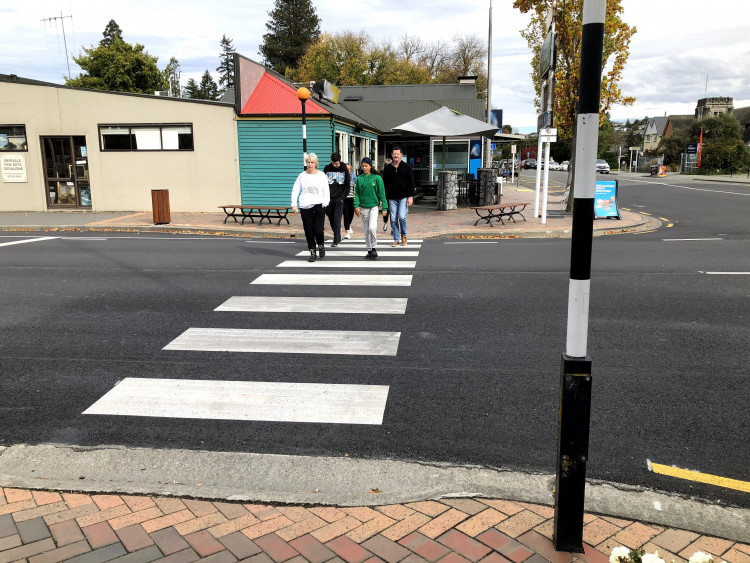
Zebra crossing, Geraldine. (Photo: Ann-Marie Head)
Check whether a zebra crossing is a suitable treatment for your site by referring to the following guidance:
PNG: Crossing selection process
Zebra crossings can be combined with other elements including kerb extensions, and pedestrian refuges or installed on a platform when they are known as raised zebra crossings.
Guidance on the design of dual use crossings for pedestrians and cyclists can be found in the Cycling Network Guidance.
Cycling Network Guidance: Unsignalised crossings
Vehicle speed is a critical factor for whether drivers yield to pedestrians. As vehicle speeds increase, the percentage of drivers who yield to pedestrians at a priority crossing decreases dramatically as shown in the figure below. Hence raised zebra crossings are recommended to slow vehicles to safe system speeds.
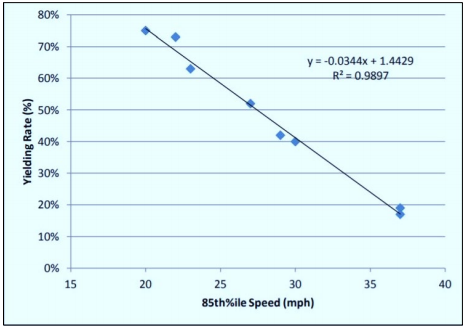
Inverse relationship between the rate of drivers yielding to pedestrians and approach traffic speed. [2]
The following table highlights considerations for the location of zebra crossings.
Table: Location considerations for zebra crossings
|
Factor |
Potential difficulties |
Solution / mitigation |
|
Posted speed > 50km/h |
Drivers are less likely to give way to pedestrians. Specific approval is required from Waka Kotahi NZ Transport Agency where the speed limit exceeds 50km/h. |
Reduce speeds. Consider alternative crossing types. |
|
Multi-lane or divided roads |
Stationary vehicles can obscure pedestrians. Some drivers will overtake a car stopped in another lane. |
Reduce to single lane in each direction. Consider alternative crossing types.
|
|
Close to intersections |
Drivers focus can be on the intersection rather than the crossing. Forward visibility of the crossing may be less than desirable. |
Ensure vehicle speeds are low (this can be reinforced through a platform at the zebra crossing). Set back the zebra crossing to provide space for a turning vehicle to yield to pedestrians out of the stream of through traffic. Consider alternative crossing types. |
A driver approaching a pedestrian crossing must give way to pedestrians on the pedestrian crossing or obviously waiting to cross it and who are not behind a school patrol sign. Drivers are required to give way to pedestrians on both sides of all zebra crossings unless the crossing is divided by a raised traffic island (Road User Rule, 10.1).
Pedestrians must not suddenly enter a pedestrian crossing when an approaching vehicle is so close that the driver is unable to give way to the pedestrian (Road User Rule, 11.5).
Land Transport (Road User) Rule 2004
There are many traffic control device requirements for zebra crossings (TCD Rule, 8.2). Key points include that:
Land Transport Rule: Traffic Control Devices 2004
Any crossing not meeting the requirements specified in the TCD Rule makes enforcement of road user obligations difficult by providing a technical defence to an errant user.
Flush medians must not be used to interrupt zebra crossings, but should be terminated either side of the crossing, with a pedestrian island installed in the centre, to divide the crossing into two stages.
Kerb ramps on the adjacent footpaths (installed to the standards in kerb ramps) provide access to zebra crossings.
Although zebra crossings may be legally up to 15m long, none should be longer than 10m. Where a longer distance is likely, kerb extensions should be used to reduce the distance travelled in one crossing movement. If kerb extensions cannot be used, pedestrian refuges may be installed instead, noting this legally divides the crossing into two stages which can be problematic in terms of vehicles giving way.
Vehicles parked close to a zebra crossing can impact on a drivers’ sightlines making it difficult to see pedestrians waiting to cross[3]. Therefore, restricting parking through the use of kerb extensions and/or no stopping lines is important.
Cyclists using a zebra crossing should take care when crossing, given that the Road User Rule does not specifically require drivers to give way to cyclists riding across a zebra crossing. Riders may therefore prefer to dismount and walk their bicycle across the roadway. If significant numbers of cyclists are expected to use the zebra crossing, then a dual crossing should be installed.
Cycling Network Guidance: Dual crossings
On-road cycle lanes or separated cycleways across zebra crossings require careful treatment. Refer to Cycle lanes at pedestrian crossings for more information.
TCD Manual Part 5 – Cycle lanes at pedestrian crossings
Typical layouts for zebra crossings are shown below.
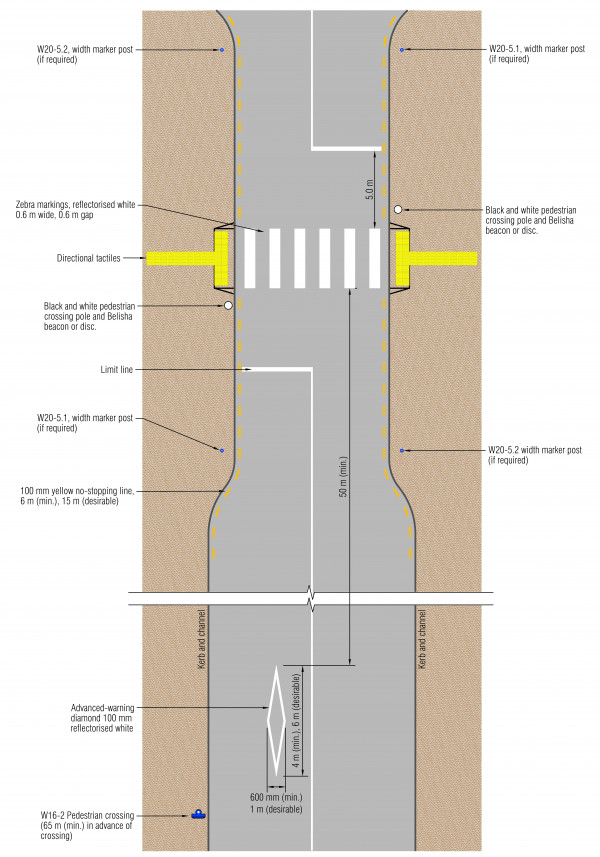
Typical layout for pedestrian crossing (zebra) with kerb extensions. (Source: TCD Manual Part 5 Figure 7-10)
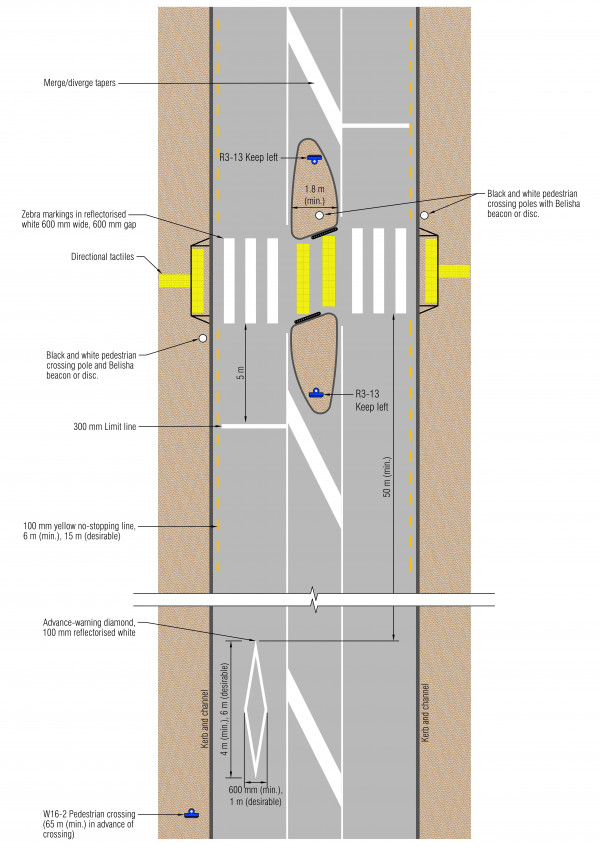
Typical layout for pedestrian crossing (zebra) with pedestrian refuge island in a flush median. (Source: TCD Manual Part 5 Figure 7-12)
The tables below outline the markings, signs and other design elements for zebra crossings. Further detail on the traffic control device elements is provided in:
TCD Manual Part 5 – Pedestrian crossings (zebra)
Table: Marking requirements for zebra crossings
| Element |
Requirement |
Additional information |
|
Crossing bars |
Bar width = 600mm |
The bars should be marked parallel to the direction of approaching traffic and so as to provide the most convenient route for pedestrians. |
|
Centre-line |
A centre-line should be marked. |
A centre-line should be marked if there is not one. The centre-line should stop short of the crossing point at the limit line. |
|
Limit lines |
300mm minimum limit lines are required. |
Located 5m in advance of the crossing bars. |
|
No-stopping lines |
No-stopping lines should be marked. |
No-stopping lines should be marked not more than 1m out from the kerb or edge of seal and for a minimum distance of 6m prior to the crossing bars. This distance should be increased to 15m where operating speeds are greater than 30km/h. |
|
Advance warning diamond |
Diamond symbol is good practice but optional |
If marked, the diamond should be at least 50m in advance of the crossing bars. There may be situations where installation of an advance warning diamond would conflict with other markings or be confusing to road users. In these situations, the diamond should be omitted. |
Sufficient contrast should be provided between the crossing bars and the roadway. Therefore use of paving, such as shown in the photo below, or red or pink colouring between the white bars does not provide sufficient contrast.
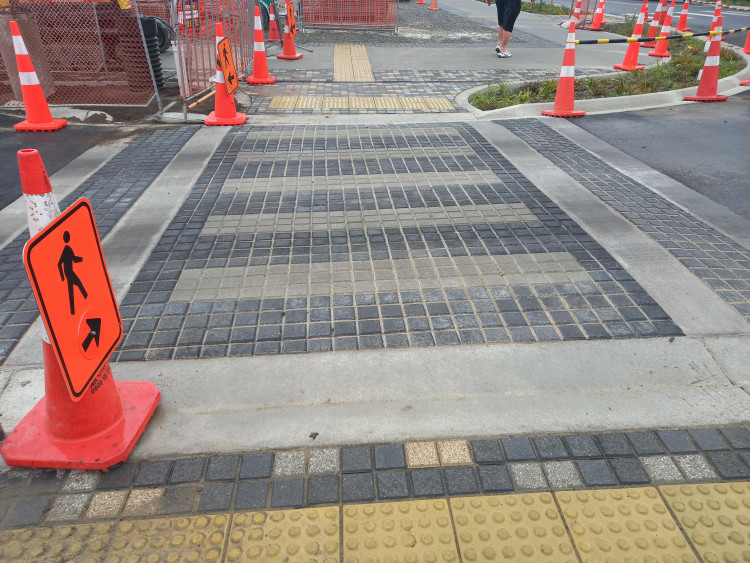
Paved zebra crossing providing insufficient contrast of white bars. (Photo: Jeanette Ward)
Table: Signage requirements for zebra crossings
| Element |
Requirement |
Additional information |
|
W16-2 Pedestrian crossing |
Must be installed in advance of all marked pedestrian crossings. |
Installation as per Table 7-6 of: |
|
W16-3 Belisha beacon disc or Belisha beacon on black and white poles |
Belisha beacon disc or a Belisha beacon installed on black and white poles located within 2m of each end of the zebra crossing. |
Table: Other design elements and considerations for zebra crossings
| Element |
Requirement |
Additional information |
|
Tactile indicators |
Warning indicators are required and directional indicators may be necessary |
|
|
Lighting |
Crossings must be illuminated at night. If the RCA is of the opinion that the crossing will not be used at night it must still be illuminated by street lighting. |
Lighting for zebra crossings should meet the requirements of AS/NZS 1158.4: 2015 Lighting of pedestrian crossings(external link) |
|
Warning lights |
On road flashing lights are rarely installed as they are relatively expensive to install and maintain and other measures to enhance safety at zebra crossings should be considered first. These include lowering vehicle speeds, vertical separation (ie. raised zebra) or conversion to a different crossing type (eg. signalised crossing). |
Further guidance on the installation of warning lights can be found in: |
|
Use of red surfacing treatment |
Red surfacing treatment is optional. A recommended approach to highlight zebra crossings whilst ensuring that sufficient contrast is provided between the crossing bars and roadway is the use of red surfacing on the vehicle approaches to the zebra crossing. |
Further guidance on the appropriate red surfacing treatment is provided below. |
Some RCAs highlight the presence of a zebra crossing to drivers and riders using coloured surfacing. However, the use of red surfacing should only be used, or approved, by an RCA in a manner that compliments and enhances regulatory markings and signs.
When installing red surfacing it is important that sufficient contrast is provided between the crossing bars and the roadway for all road users. Visually impaired road users have reported that red and pink colouring between the white bars does not provide adequate contrast. Red coloured surfacing is permitted under the Land Transport Rule (Traffic Control Devices) provided it is not part of or visually integrated into an official road marking. Refer to the Roadway art guidance for further information.
Draft Handbook for Tactical Urbanism in Aotearoa - Roadway Art guidance
The result of this is that it is not recommended practice to apply red coloured surfacing immediately beneath the zebra crossing bar markings.
A recommended approach that meets the needs of all road users and aligns with the above legislation is to apply areas of red coloured surfacing on the vehicle approaches to zebra crossings as shown in the figures below with dimensions outlined in the following table.
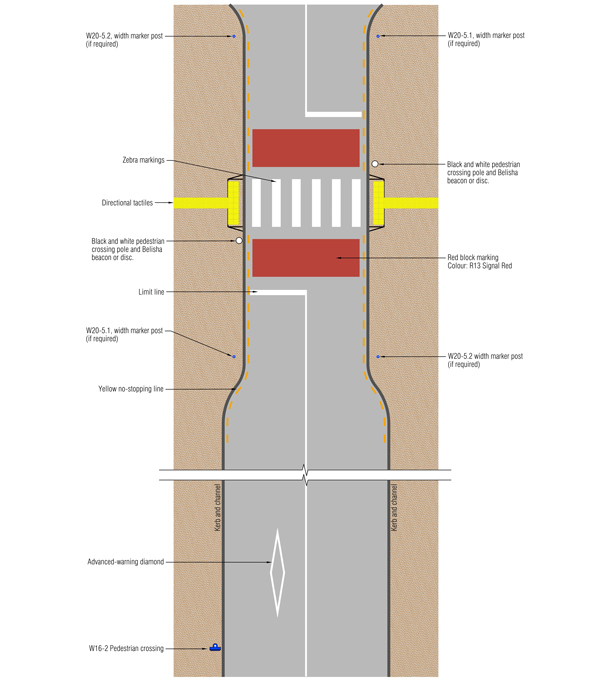
Typical layout for zebra crossing with red surfacing treatment.
The recommended colour for red is R13 Signal Red, as set out in the P33 specifications with the layout dimensions outlined in the table below. The red surfacing must not encroach onto the no-stopping lines.
P33 Specification for coloured pavement surfacings
Table: Red surfacing treatment dimensions
| Marking |
Dimension |
|
Typical length of red surfacing |
3.0m |
|
Minimum gap between red surfacing and limit line |
0.5m |
|
Minimum gap between red surfacing and crossing bars |
0.5m |
Note that the dimensions of red surfacing treatments at raised zebra crossings are different.
[1] Corben, B. (2020). Integrating Safe System with Movement and Place for Vulnerable Road Users(external link), Austroads, AP-R611-20, p19
[2] Bertulis, T., & Dulaski, D. M. (2014). Driver approach speed and its impact on driver yielding to pedestrian behavior at unsignalized crosswalks. Transportation Research Record, 2464(1), 46-51
[3] Huard, K. (2021). Zebra crossings: A threatened species in New Zealand? 2Walk and Cycle conference paper(external link),